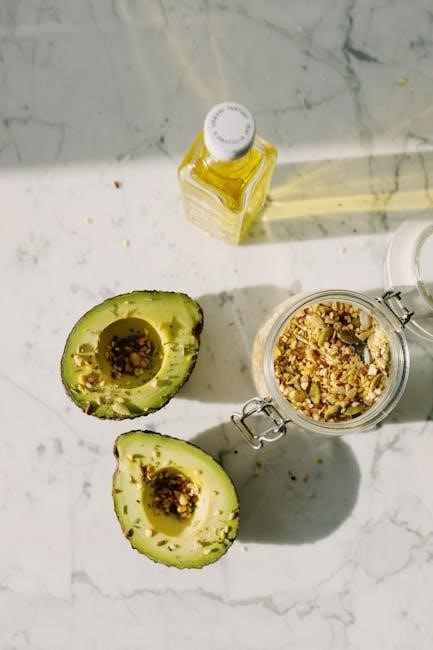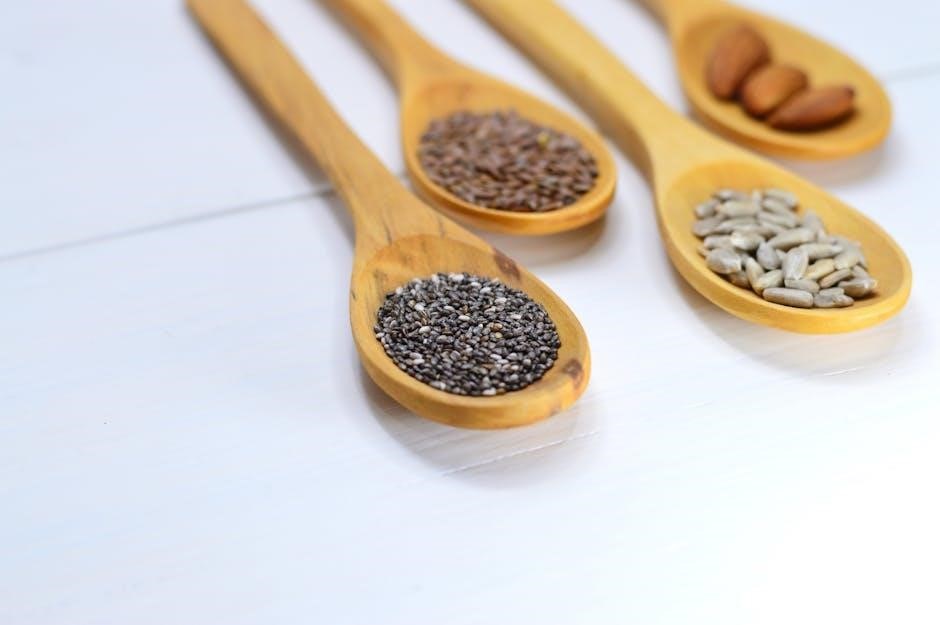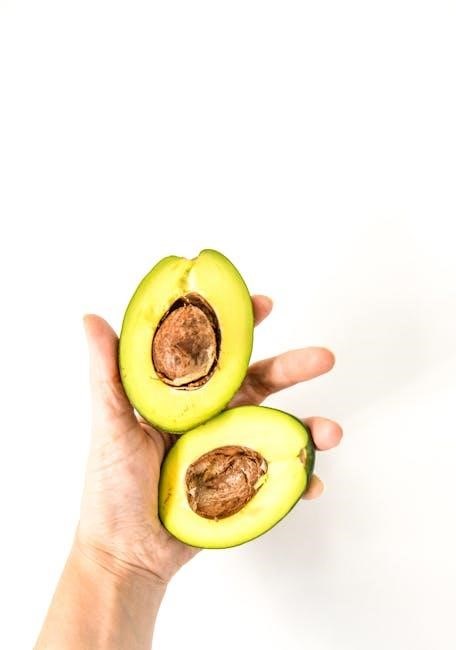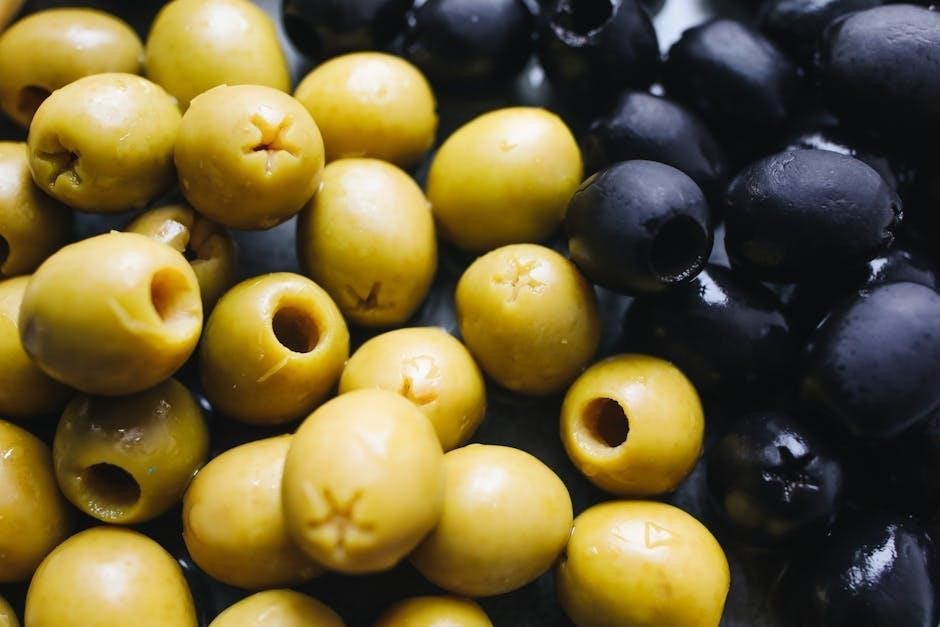The low salicylate diet is an eating plan that restricts foods containing salicylic acid, naturally found in certain plants and added to medications․ It helps manage sensitivity․
By eliminating high-salicylate foods, individuals can reduce symptoms like digestive issues or skin rashes, potentially improving overall well-being․ Consult a healthcare provider before starting this diet․
1․1 What is a Low Salicylate Diet?
A low salicylate diet is a specialized eating plan designed to minimize or eliminate foods and products containing salicylic acid, a naturally occurring compound in plants․ It aims to reduce symptoms associated with salicylate sensitivity, such as digestive issues, skin rashes, or inflammation․ The diet involves an initial elimination phase, removing high-salicylate foods for about four weeks, followed by a gradual reintroduction to identify tolerance levels․ This approach helps individuals manage intolerance and improve their overall health, often under medical or dietary guidance․
1․2 Importance of Understanding Salicylate Sensitivity
Understanding salicylate sensitivity is crucial for individuals experiencing symptoms like digestive discomfort, skin rashes, or inflammation․ Salicylates, found in foods and medications, can trigger intolerance in sensitive individuals․ Recognizing sensitivity allows for targeted dietary adjustments, such as adopting a low salicylate diet, to alleviate symptoms․ Ignoring sensitivity may lead to prolonged health issues, while proper management can significantly improve quality of life․ Early identification and personalized dietary strategies are key to achieving relief and maintaining long-term well-being․
1․3 How the Low Salicylate Diet Can Improve Symptoms
A low salicylate diet can significantly reduce symptoms of salicylate intolerance, such as digestive issues, skin rashes, and inflammation․ By eliminating high-salicylate foods, the body is less exposed to irritants, allowing it to heal․ Many individuals report improved digestion, clearer skin, and reduced inflammation․ The diet may also enhance energy levels and overall well-being by addressing underlying sensitivities․ Consistent adherence to the diet often leads to noticeable symptom relief within weeks, making it a valuable approach for managing salicylate-related discomfort and promoting better health outcomes․

What Are Salicylates?
Salicylates are organic compounds, both natural and synthetic, found in plants and medications․ They act as preservatives or active ingredients, but can cause intolerance in sensitive individuals․
2․1 Definition and Sources of Salicylates
Salicylates are naturally occurring compounds found in plants, serving as defense mechanisms․ They are present in fruits like berries, citrus, and apples, as well as vegetables such as tomatoes and eggplants․
Other sources include nuts, seeds, and whole grains․ Herbs and spices like turmeric and cumin also contain salicylates․ Synthetic forms are found in medications and personal care products, contributing to potential sensitivity issues․
2․2 Foods High in Salicylates
Foods high in salicylates include berries, citrus fruits, apples, and tomatoes․ Nuts, seeds, and whole grains also contain significant amounts․ Herbs and spices like turmeric, cumin, and paprika are high in salicylates․ Processed foods and additives may contain synthetic salicylates, contributing to sensitivity․ Understanding these sources is crucial for managing salicylate intake and reducing potential intolerance symptoms․
2․3 Salicylates in Medications and Personal Care Products
Salicylates are commonly found in medications like aspirin and some anti-inflammatory drugs․ Personal care products, such as shampoos, lotions, and fragrances, may also contain salicylates․ These sources can contribute to overall salicylate intake, potentially worsening sensitivity․ Even natural products like certain skincare items may include salicylate derivatives․ It’s important to review labels and consult a healthcare provider to manage exposure effectively, as these hidden sources can impact those following a low-salicylate diet․
Benefits of a Low Salicylate Diet
A low salicylate diet can alleviate intolerance symptoms, improve digestion, and reduce inflammation․ It may also boost energy levels and enhance overall well-being for sensitive individuals․
3․1 Relief from Salicylate Intolerance Symptoms
Adopting a low salicylate diet can significantly alleviate symptoms of salicylate intolerance, such as digestive discomfort, skin rashes, and respiratory issues․ By reducing salicylate intake, individuals often experience a noticeable improvement in their condition․

Common symptoms like headaches, bloating, and irritability may diminish or disappear entirely․ This dietary approach helps the body avoid triggers, providing much-needed relief and improving quality of life for those with sensitivity․
3․2 Improved Digestion and Reduced Inflammation
A low salicylate diet often leads to improved digestion by minimizing irritants that can disrupt the gastrointestinal system․ Many individuals report reduced bloating, fewer stomach discomforts, and enhanced nutrient absorption․
By eliminating salicylate-rich foods, inflammation in the body can decrease, which may alleviate conditions like skin irritation or joint pain․ This dietary adjustment supports a healthier digestive tract and overall bodily function․
3․3 Enhanced Overall Well-being and Energy Levels
Adopting a low salicylate diet can significantly boost overall well-being by reducing symptoms linked to salicylate sensitivity, such as fatigue and brain fog․ Many individuals experience increased energy levels as their bodies are no longer reacting to irritants․
With improved digestion and reduced inflammation, the body functions more efficiently, leading to enhanced mental clarity and a general sense of vitality․ This dietary approach supports long-term health and quality of life for those with salicylate intolerance․

Implementing the Low Salicylate Diet
Start by eliminating high-salicylate foods for four weeks, then gradually reintroduce them to identify tolerances․ Track symptoms and adjust accordingly, ensuring a balanced and nutritious meal plan․
4․1 Steps to Start the Diet
Starting a low salicylate diet involves careful planning․ Begin by identifying and eliminating high-salicylate foods from your meals․ Create a meal plan focusing on low-salicylate options․ Read food labels to avoid hidden sources and cross-contamination․ Keep a symptom journal to track improvements․ Gradually reintroduce foods after four weeks to test tolerance․ Consult a dietitian for personalized guidance and ensure nutritional balance․ Stay committed to the process, as consistency is key to managing symptoms effectively and achieving long-term success․
4․2 Elimination Phase: Removing High-Salicylate Foods
The elimination phase involves removing all high-salicylate foods and products for at least four weeks․ This includes fruits, vegetables, spices, and medications containing salicylates․ Focus on consuming low-salicylate alternatives, such as certain meats and grains; Avoid processed foods, as they often contain hidden salicylates․ Keep a detailed food diary to monitor symptoms and identify potential triggers․ This phase helps determine if salicylate sensitivity is the cause of symptoms and prepares for the reintroduction phase to assess tolerance levels․ Consistency is crucial for accurate results;
4․3 Reintroduction Phase: Identifying Tolerances
The reintroduction phase follows the elimination period, allowing individuals to gradually add high-salicylate foods back into their diet․ Start with one food at a time, in small portions, and monitor for symptoms․ Keep a food diary to track reactions and tolerance levels․ This phase helps identify which foods can be safely included and at what amounts․ It’s crucial to wait 2-3 days between introductions to accurately assess tolerance․ This step-by-step approach ensures personalized dietary adjustments and minimizes the risk of overwhelming the system․ Professional guidance is recommended for clarity and safety․

Foods to Avoid on a Low Salicylate Diet
Eliminate high-salicylate foods like berries, citrus fruits, tomatoes, and processed items․ Avoid foods with added preservatives or artificial flavorings, as they often contain salicylates․ Always check labels carefully․
5․1 High-Salicylate Foods: A Comprehensive List
Foods high in salicylates include berries (like strawberries, blueberries, and raspberries), citrus fruits (oranges, lemons, grapefruits), tomatoes, and processed foods with artificial additives․ Herbs and spices like curry, thyme, and cumin are also high․ Alcohol, such as wine and beer, contains salicylates, as do certain teas and coffee․ Processed foods, candies, and medications with salicylic acid derivatives should be avoided․ Always check food labels for hidden sources, as salicylates are often added as preservatives or flavor enhancers․
5․2 Hidden Sources of Salicylates in Processed Foods
Processed foods often contain hidden salicylates in the form of additives, preservatives, or flavor enhancers․ Common culprits include artificial food colorings, flavorings, and anti-caking agents like BHA and BHT․ Many processed snacks, candies, and ready-to-eat meals contain salicylates․ Additionally, salicylic acid derivatives are sometimes added to extend shelf life or enhance taste․ Always check food labels for terms like “spice blends” or “natural flavors,” as these may indicate salicylate content․ Even small amounts can accumulate, making label scrutiny crucial for those on a low-salicylate diet․
5․3 Cross-Contamination and Food Labeling Tips
Cross-contamination can occur in food production, making even low-salicylate foods risky․ Choose products from manufacturers that test for salicylates and adhere to strict allergen protocols․ Always read labels carefully, as terms like “may contain” or “processed in facilities with” can indicate potential contamination․ Opt for certified low-salicylate or hypoallergenic options when possible․ For added safety, contact manufacturers to confirm salicylate levels in their products․ This proactive approach helps minimize exposure and ensures compliance with your dietary needs․

Foods to Include on a Low Salicylate Diet
Fresh meats, poultry, fish, and select vegetables are ideal for a low-salicylate diet․ These foods are naturally low in salicylates and support symptom reduction when consumed consistently․
6․1 Low-Salicylate Food Options: Fresh and Whole Foods
Fresh meats, poultry, and fish are excellent low-salicylate choices․ These foods are naturally free from salicylates and provide essential nutrients․ Certain vegetables like potatoes and green beans are also safe․ Fresh fruits such as bananas and pears are low in salicylates․ Whole grains like rice and oats are suitable options․ Eggs, dairy products, and healthy fats like olive oil are also recommended․ These foods form the foundation of a balanced and nutritious low-salicylate diet, helping to minimize symptoms while ensuring adequate nutrition․ Always opt for fresh, unprocessed varieties to avoid hidden additives․
6․2 Safe Herbs and Spices for Cooking
Certain herbs and spices are naturally low in salicylates, making them ideal for cooking on this diet․ Basil, mint, and parsley are safe choices for adding flavor․ Salt, pepper, and ginger are also low in salicylates and can enhance meals․ Avoid high-salicylate options like curry, cumin, and cloves․ Fresh or dried versions of these herbs are preferable to processed blends, which may contain hidden additives․ Incorporating these spices can help maintain variety and enjoyment in your low-salicylate meal plan․
6․3 Building a Balanced and Nutritious Meal Plan
A balanced low-salicylate meal plan focuses on whole, unprocessed foods․ Incorporate lean proteins like chicken, fish, and eggs, paired with low-salicylate vegetables such as lettuce, carrots, and green beans․ Healthy fats from avocado and olive oil support nutrition․ Whole grains like rice and quinoa provide sustained energy․ Fresh fruits like bananas and pears are safe choices․ Regularly consult a dietitian to ensure adequate nutrient intake and adjust portions based on individual needs․ This approach ensures meals are both nourishing and compliant with the diet․

Managing Salicylate Intolerance
Recognizing symptoms like rashes or digestive issues is key․ An elimination diet helps identify triggers, guiding personalized strategies to reduce salicylate intake and alleviate discomfort effectively․
7․1 Recognizing Symptoms of Salicylate Sensitivity
Common symptoms of salicylate sensitivity include rashes, hives, itching, and digestive issues like bloating or stomach pain․ Some individuals may experience headaches, fatigue, or difficulty breathing․
In severe cases, symptoms can escalate to anaphylaxis, a life-threatening allergic reaction․ Tracking these symptoms after consuming high-salicylate foods can help identify sensitivity and guide dietary adjustments․
7․2 Working with a Healthcare Provider or Dietitian
Collaborating with a healthcare provider or dietitian is crucial for managing salicylate sensitivity․ They can help tailor a personalized diet plan and monitor symptoms, ensuring safe and effective implementation․
A professional can guide food reintroduction, identify triggers, and recommend supplements to address deficiencies․ Regular follow-ups help maintain long-term adherence and optimize health outcomes on the low salicylate diet;
7․3 Lifestyle Adjustments to Support the Diet
Adopting a low salicylate diet requires mindful lifestyle changes․ Meal planning and grocery shopping strategies help avoid high-salicylate foods․ Reading labels carefully is essential to identify hidden sources of salicylates in processed products․
Cooking from scratch using fresh ingredients ensures better control over salicylate intake․ Managing stress through relaxation techniques can reduce symptom severity․ Informing friends and family about dietary needs fosters a supportive environment․ Tracking progress and symptoms helps refine the diet for long-term success․

Common Challenges and Solutions
Common challenges include cravings, social pressures, and nutritional gaps․ Solutions involve meal planning, seeking support groups, and consulting a dietitian to ensure a balanced diet․
8․1 Dealing with Cravings and Social Pressures

Cravings for high-salicylate foods can be challenging․ Focus on finding low-salicylate alternatives to satisfy cravings, such as using safe herbs or spices for flavor․ Social pressures, like eating out or attending gatherings, require planning․ Communicate your dietary needs to hosts and bring suitable dishes to share․ Staying committed to your diet is key, as the long-term health benefits outweigh temporary indulgences․ Seek support from online communities or friends to stay motivated and navigate social situations confidently․
8․2 Managing Nutritional Deficiencies on the Diet
A low-salicylate diet may lead to nutritional deficiencies if not planned carefully․ Focus on consuming a variety of low-salicylate foods rich in vitamins, minerals, and fiber․ Incorporate fortified foods or supplements, especially for nutrients like folate or iron, which may be limited․ Regularly review your diet with a healthcare provider or dietitian to identify gaps․ Balancing nutrient intake ensures long-term health while adhering to the dietary restrictions․ Proper planning and professional guidance are essential to maintain optimal nutrition and prevent deficiencies․
8․3 Staying Motivated and Compliant Long-Term
Staying motivated on a low-salicylate diet requires commitment and strategic planning․ Begin with clear goals, such as improved health or symptom relief, to maintain focus․ Meal planning and grocery lists can help avoid impulsive choices․ Celebrate small milestones, like completing the elimination phase, to stay encouraged․ Seek support from online communities or friends for shared recipes and tips․ Tracking progress in a journal can also highlight improvements and keep motivation strong․ Remember, consistency is key to long-term success and better well-being․

Success Stories and Testimonials
Many individuals report significant improvements in symptoms after adopting a low-salicylate diet․ Parents share stories of children with behavioral issues showing calmness and focus after dietary changes․
9․1 Real-Life Experiences with the Low Salicylate Diet
Individuals have shared remarkable journeys with the low-salicylate diet, noting drastic reductions in symptoms like rashes, digestive discomfort, and mood swings․ Parents often highlight improvements in their children’s behavior, with decreased irritability and enhanced focus․ Many report feeling more energetic and mentally clear after adhering to the diet․ These testimonials underscore the diet’s potential to transform lives, offering hope for those struggling with salicylate sensitivity․ The personal stories serve as powerful motivation for others considering this dietary approach․
9․2 Positive Outcomes and Symptom Improvement
Adhering to the low-salicylate diet has led to significant symptom improvement for many individuals․ Common benefits include reduced inflammation, alleviation of digestive issues, and clearer skin․ Many report a noticeable decrease in chronic pain and allergic reactions․ Improved mental clarity and reduced fatigue are also frequently cited․ Parents of children with salicylate sensitivity often observe enhanced focus and calmer behavior․ These positive outcomes highlight the diet’s effectiveness in addressing intolerance symptoms, promoting overall health and well-being․ The improvements encourage long-term commitment to the dietary changes․
9․3 Tips from Those Who Have Succeeded
Individuals who have successfully followed the low-salicylate diet emphasize the importance of thorough planning and organization․ They recommend creating a detailed meal plan and keeping a symptom journal to track progress․ Reading food labels carefully and avoiding processed foods are key․ Many suggest starting with simple, whole-food recipes and gradually experimenting with safe ingredients․ Reintroducing foods slowly during the testing phase is crucial to identify tolerances․ Staying connected with support groups and seeking professional guidance also helps maintain long-term compliance and motivation․
The low-salicylate diet offers a structured approach to managing sensitivity and improving symptoms․ Consulting a healthcare provider and staying committed to the diet are key next steps․
10․1 Summarizing the Key Points of the Diet
The low-salicylate diet focuses on eliminating foods and products containing salicylic acid to alleviate sensitivity symptoms․ It involves an initial elimination phase, followed by gradual reintroduction to identify tolerances․ The diet aims to reduce inflammation, improve digestion, and enhance overall well-being․ Success requires commitment, careful planning, and consultation with a healthcare provider․ By understanding salicylate sources and avoiding high-salicylate foods, individuals can better manage their intolerance and achieve long-term symptom relief, leading to a more balanced and nutritious lifestyle․
10․2 Encouragement for Starting the Journey
Embracing the low-salicylate diet can be life-changing, offering relief from symptoms and improved health․ While it may seem challenging, the benefits of reduced inflammation and enhanced well-being make it worthwhile․ Remember, small steps lead to big changes—start with a clear plan and seek support from healthcare providers or dietitians․ hearing success stories from others who’ve thrived on this diet can inspire confidence․ Take the first step today and discover how this journey can transform your life for the better․
10․3 Final Thoughts on the Importance of the Low Salicylate Diet
The low-salicylate diet is a powerful tool for managing salicylate intolerance, offering symptom relief and improved health․ By focusing on whole, low-salicylate foods, individuals can reduce inflammation and enhance their quality of life․ While it requires dedication, the long-term benefits of better digestion, energy, and overall well-being make it a valuable approach․ With proper guidance and persistence, this diet can be a transformative step toward achieving optimal health and vitality․

No Responses